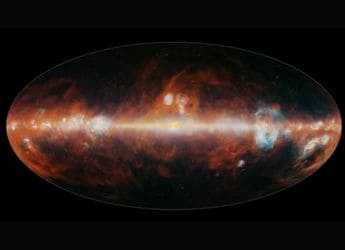- Home
- Science
- Science News
- Webb Telescope Spots Possible Jellyfish Galaxy 12 Billion Light Years Away
Webb Telescope Spots Possible Jellyfish Galaxy 12 Billion Light-Years Away
A distant galaxy 12 billion light-years away shows signs of being a jellyfish galaxy, with trailing streams of gas caused by ram pressure stripping.

Photo Credit: NASA/ESA
Astronomers using JWST found a jellyfish galaxy 12 billion light-years away with trailing gas tails
Astronomers have discovered a new “jellyfish” galaxy about 12 billion light-years away using the James Webb Space Telescope. It appears to have tentacle-like streams of gas and stars trailing off one side, a signature feature of jellyfish galaxies. These galaxies develop such trails via ram pressure stripping as they move through dense cluster environments, triggering star formation in the stripped gas. The find was made by Ian Roberts of Waterloo University, and details are described in a preprint on arXiv. More analysis is needed to confirm the classification, but early signs strongly suggest this object is indeed a jellyfish galaxy.
What Are Jellyfish Galaxies?
According to NASA, jellyfish galaxies are so named because of the long, trailing streams of gas and young stars that extend from one side of the galaxy. This phenomenon occurs when a galaxy moves rapidly through the hot, dense gas in a cluster, and ram pressure strips material away. The stripped gas forms a wake behind the galaxy, and this wake often lights up with bursts of new star formation. At the same time, the process can deprive the galaxy's core of gas, potentially slowing star formation in the galaxy's center.
Because the jellyfish stage is short-lived on cosmic timescales, astronomers rarely catch galaxies in this act. Studying jellyfish galaxies gives scientists insight into how dense environments affect galaxy evolution and star formation.
Discovery and Future Research
The researchers caution that the galaxy's apparent “tentacles” may partly be an artifact of the imaging method. If confirmed, this object (COSMOS2020-635829) would be the most distant known jellyfish galaxy, offering a rare glimpse of how ram pressure stripping and cluster-driven quenching operated in the early cosmos. As the study authors note, finding a jellyfish at z>1 reinforces the idea that these environmental effects were already at work near the peak of cosmic star formation.
Get your daily dose of tech news, reviews, and insights, in under 80 characters on Gadgets 360 Turbo. Connect with fellow tech lovers on our Forum. Follow us on X, Facebook, WhatsApp, Threads and Google News for instant updates. Catch all the action on our YouTube channel.
Related Stories
- Samsung Galaxy Unpacked 2025
- ChatGPT
- Redmi Note 14 Pro+
- iPhone 16
- Apple Vision Pro
- Oneplus 12
- OnePlus Nord CE 3 Lite 5G
- iPhone 13
- Xiaomi 14 Pro
- Oppo Find N3
- Tecno Spark Go (2023)
- Realme V30
- Best Phones Under 25000
- Samsung Galaxy S24 Series
- Cryptocurrency
- iQoo 12
- Samsung Galaxy S24 Ultra
- Giottus
- Samsung Galaxy Z Flip 5
- Apple 'Scary Fast'
- Housefull 5
- GoPro Hero 12 Black Review
- Invincible Season 2
- JioGlass
- HD Ready TV
- Laptop Under 50000
- Smartwatch Under 10000
- Latest Mobile Phones
- Compare Phones
- Huawei Nova 15
- Huawei Nova 15 Pro
- Huawei Nova 15 Ultra
- OnePlus 15R
- Realme Narzo 90x 5G
- Realme Narzo 90 5G
- Vivo S50 Pro Mini
- Vivo S50
- Asus ProArt P16
- MacBook Pro 14-inch (M5, 2025)
- Huawei MatePad 11.5 (2026)
- OnePlus Pad Go 2 (5G)
- OnePlus Watch Lite
- Just Corseca Skywatch Pro
- Acerpure Nitro Z Series 100-inch QLED TV
- Samsung 43 Inch LED Ultra HD (4K) Smart TV (UA43UE81AFULXL)
- Asus ROG Ally
- Nintendo Switch Lite
- Haier 1.6 Ton 5 Star Inverter Split AC (HSU19G-MZAID5BN-INV)
- Haier 1.6 Ton 5 Star Inverter Split AC (HSU19G-MZAIM5BN-INV)

















